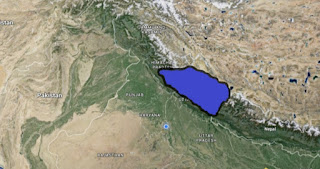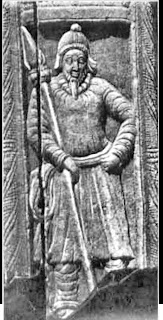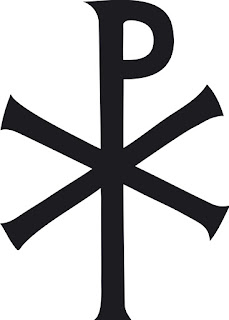The predominantly mountainous region comprising the present day Himachal Pradesh (HP) has been inhabited since pre-historic times and witnessed multiple waves of human migration from other areas. Through its history, the region was mostly ruled by local kingdoms. The foothills of modern HP were inhabited by people from the Indus Valley Civilization between 2250 and 1750 BCE. Tribes such as Kols and Mundas are believed to be the original inhabitants to the hills of present-day HP followed by the Bhotas and Kiratas. During the Vedic period, several small republics known as Janapadas existed which were later conquered by the Gupta Empire. Heun Tsang, a Chinese traveller, visited India from 629AD to 644 AD, during Harshvardhana's rule and he has mentioned about all the kings ruling in the region.
The designs of Indo-Greek coins had a very great influence on coins of this region.
Kuninda Coin, 1st century BC
The Audumbaras. They are mentioned by the grammarian Panini in his Mahabhasya (4th century BCE), by Ptolemy, the geographer in 2nd century AD as the "Odomboerae" and the epic Mahabharata testifies that Audumbaras were descendants of the sage Vishwamitra, who founded the gotra of the Kaushika group. The name comes from the fig tree, the audumbar. This tree is related to the birth of Vishwamitra, whose mother is said to have embraced a fig tree, so the story says. They were one of the famous tribes of ancient HP. They were located between the Beas and upper Sutlej and Ravi, from their coin finds. Their coins have been found in Kangra, Jwalamukhi, Pathankot, Gurdaspur and Hoshiarpur regions. A Buddhist scholar Chandragomin in the 5th century AD refers to the Audumbaras in his book Vritti as a section of 'Shalvas'. Their coins are found from 2nd century BC to the 1st century AD.
The tribe had an elected king. Their coins inscribed in Brahmi and Kharosti are supported by a Trident figure. Their influence is also testified by Buddhist texts like "The Vinaya".
Trigarta. Literally means 'the three valleys' formed and drained by the three rivers of Satluj, Beas and Ravi. Historically, Trigarta first finds mention in the works of Panini from the 5th century BC who calls the inhabitants of Trigarta as "Ayudhjeevi Sangha" or a martial republic. The kingdom is mentioned in the epic Mahabharata, Brihatsamhita and Vishnu Purana. Modern day Kangra is one of the towns in north Trigarta, extending westwards to the Punjab area. Multan was the capital of Trigarta with its original name being Mulasthan. The kings were allies of Duryodhan and enemies of Pandavs and Viratas. Their capital was named Prasthala. Tigarta kings fought the Kurukshetra war and were killed by Arjun, after a ruthless conflict.
Arjun also annihilated an Akshouhini of Trigarta warriors called the Samsaptakas.
These warriors had vowed to either kill Arjun or die as part of the larger plan by Duryodhan to capture Yudhishthir alive. The Katoch dynasty is an offshoot of the Trigratraje dynasty. Katoch clan has few branches, Jaswal, Guleria, Sibaia, Chib and Dadwal.
Kangra Fort
Kuluta. Kullu was known as Kuluta in ancient times. Mentioned in early literary texts including the "Mahabharatas". Hiuen Tsang places Kuluta country 700 li or 117 miles to the northeast of Jalandhara. The Chamba copper plate inscription mentions Kalutas with their neighbouring people, the Trigartas and the Kiras. Located in upper Beas valley with its capital at Naggar. The oldest historical record of the kulutas is the legend on a coin found in the Kullu valley bearing the name of "Virayasasyarajna kulutasya", or Kullu king Virayasa. It was a tribal republic of Janapada.
Krishna Temple, Naggar, 1863 AD
The ruling family, the tradition holds, 'came from Mayapur (Haridwar)'. The provenance of the silver coins and the similarity to the coins of Audumbaras and Kunindas suggest their territories were not far separated from each other.
The Vemakis. They are known from their round silver coins reported from Ambala and Chandigarh in Punjab. They too find a mention in the Mahabharata. Their coins are typically bi-scriptural with a bull facing a spoke wheel on the obverse and an elephant facing a Trident- Battle-axe on the reverse. The kings mentioned are Rudravarman, Bhavavarman and Shivaghosha and the Vemakis appear to have ruled in the 1st century BCE.
Drachm, 101-1 BC, silver, weight 2.2 g
Obverse: Brahma bull facing right with lotus flower in front, surrounded by Karoshti legend
Reverse: Elephant facing right with Trident in front, surrounded by Brahmi legend.
The Kunindas. The kingdom of Kuninda was a Himalayan kingdom that existed from around the 2nd century BC to the 3rd century AD, located in the modern state of Uttarakhand and southern areas of Himachal Pradesh.
The Greek historian Ptolemy linked the origin of the Kuninda to the country where the rivers Ganges, Yamuna and Sutlej originate.
Map showing Kuninda Kingdom, 2nd century BC
The Kuninda kingdom disappeared around the 3rd century, and the region shifted to Shaivite beliefs. The coins of Kuninda were influenced by the numismatic designs of the Indo- Greek kingdom and followed their weight and size standards. Kuninda coins are often found together with the Indo-Greek coins in hoard, particularly those of Apollodotus. A very large number of Kuninda coins are in the name of king Amoghabhuti and these continued even after his death.
Silver drachm, Kuninda kingdom, 200 BC-100 AD, weight 2,2 gm
A variant of the earlier coin having having a three arched hill between the deer's legs, weight 2.1 gm
They were mostly found in the present day Sirmaur and Shimla hills between present day Ambala, Saharanpur and areas of the plains of Shivalik hills.
Guptas. Chandragupta (320-335 AD) captured the republics of the Himachal without the use of force though he usually did not rule them directly. The Allahabad pillar inscription mentions this fact. Ashoka, his grandson extended his boundaries to the Himalayan region. He introduced Buddhism to the state. He also built various stupas there.
The Ashoka Pillar at Allahabad
Inscription on the Ashoka Pillar
Chandragupta I, Dinar, 319-343 CE, King and Queen type,
Harsha (590-647 AD). After the collapse of the Guptas and before the rise of Harsha, the area was again ruled by chiefs also known as Thakurs and Ranas. With the rise of Harsha in the 7th century, most of the small provinces acknowledged its all-round supremacy though many local powers remained with the chiefs.
Obverse: Head of king left, wearing crescent-topped crown
Reverse: Fan-tailed peacock facing, Brahmi legend around
Rajput Period. After Harsha's death (647 AD), Rajput states ascended in Rajasthan and Indus plains. They moved to the hills with their followers, where they established small provinces or principalities. Some of these were Kangra, Nurpur, Suket, Kutlehar, Baghal, Bilaspur, Nalagarh, Keonthal, Dhami, Kunihar, Bushahar and Sirmour
























































